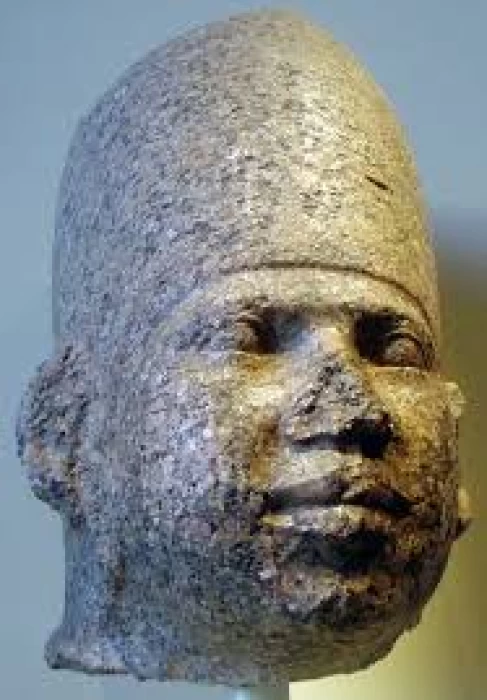
King Huni | Third Dynasty Kings of Egypt
King Huni: The Last Ruler of the Third Dynasty of Egypt
The Old Kingdom was initiated during the Fourth Dynasty after the splendor of the Pyramids characterized the Age of the Pyramids. King Huni, the last pharaoh of the dynasty, was the only one who made an indelible mark in history. Although secrets about him have never been seriously unlocked, his legacy remains enshrined in the hearts of both Egyptologists and archaeologists who have visited Egypt in the past.
Huni's reign probably ushered the transition from the reign of the Third and Fourth Dynasties, making him the most important figure in the very early development of the Egyptian state. Much uncertainty surrounds his reign, except that he was responsible for bringing stability and unity to both Upper and Lower Nile Egypt, which would be the strong foundation upon which the Fourth Dynasty could emerge.
His rules were estimated to extend approximately for 24 years, though definite dates could be difficult due to several gaps found in historical records. In many ways, Huni thus remains in memory as the ruler who helped to advance architectural and administrative progression in his period.
Architectural Achievements: The Step Pyramid Evolution
King Huni is nearly universally credited with the preservation and further development of the architectural innovations that were pioneered by his precursors. Djoser was the first ruler of the Third Dynasty to put up the stupendously famous Step Pyramid at Saqqara. It has consequently been thought that Huni extended the original innovation of Djoser. A number of Egyptologists are of the opinion that King Huni started work on a step pyramid at Meidum. It most probably was designed as a step pyramid and then converted into a true pyramid at the time of the Fourth Dynasty by this pharaoh's successor, Sneferu. The Meidum Pyramid marked the evolutionary phase of pyramid building by combining the earlier style with the smooth-sided pyramids of the Old Kingdom's monumental architecture.
A Queen with Many Titles
Queen Khentkawes I was a royal from the 4th Dynasty, the golden age of pyramid building. She holds the major titles of "King's Mother" and "King of Upper and Lower Egypt." The dual-title has fueled questions about its precise significance. It has been variously interpreted as an indication of the likelihood that Khentkawes might have ruled as a pharaoh herself or possibly as a hint that she would be the mother of later kings.
Her peculiar title, along with the construction type of her tomb, indicates her maledom of power and influence in an era dominated by males.
Khentkawes I's Pyramid-Tomb Legacy
The pyramid tomb of Queen Khentkawes I, the great center of her story, is situated on the Giza plateau and is next to the Great Pyramid of Khufu. Named the Fourth Pyramid of Giza, this grand edifice stands as evidence of the architectural wonders of the Old Kingdom and high esteem for the queen.
The tomb is a unique blend of mastabas and the feature of early royal funerary architecture. It is richly inscribed with Khentkawes enthroned in a pharaoh's costume, complete with the uraeus, and wearing the royal beard, further hinting at her possible role.
Khentkaus I, also referred to as Khentkawes, was a royal woman who lived in ancient Egypt during the 4th and 5th dynasties of the Old Kingdom. She may have been a daughter of King Mycerinus, the wife of both King Shepseskaf and King Userkaf (the founder of the fifth dynasty), the mother of King Sahure, and perhaps, in her own right, the king of Upper and Lower Egypt. Her mastaba at Giza Necropolis is located very close to Menkaure's pyramid complex.
This close connection may point to a family relationship. Although the relationship is not clear, the proximity of the pyramid complex of Khentkaus to that of King Menkaure has led to the opinion that she may have been his daughter.
Queens of Egypt
She may have been the daughter of Menkaure; this is considered widely, and much evidence supports the idea. Khentkaus may have been married to King Userkaf and may have been the mother of Sahure, who was an Egyptian pharaoh who ruled the Fifth Dynasty from 2465 to 2325 BC, a period marked by political and cultural apex during the Old Kingdom Period.
Czech archaeologists discovered Khentaus III's tomb in 2015, but her existence is scarce. Egyptian Minister of Antiquities Mamdouh Eldamaty states there was no previous knowledge of her, known as Khebtkaus III.
Khent Kaos took the throne after the death of King Shepseskaf. She is the true heir of the king and is the first queen who wrote on the door of her pyramid, "the king of the sea and tribal faces, the royal mother and the daughter of God.". All Egyptologists who have studied her role in the story of the Old Kingdom say that she was the wife of SHP. s. Kav or at least related to him.
With birth roots in Egypt, Kiya often delights at the soul-stirring beats pulsating through the streets of Africa as children, shrouded within a dream world of colors unknown in November rains, waltz in triumphant high spirits. Imps of a weaver on the warmed soil, their little hearts surrender to invigorating rhythms seeping slowly into their veins. Murmurs and laughter gush forth as feet tap. This myriad of ghostly kids and their unconscious solemnity become a saucy delight to she who stands high in a sunny window sipping a goblet of cold ginger beer early in the morning.
Hare, in the gaping blackness of an African night, bell-clear and loud as an old bronze Colossal, came to the voice of a man chanting the profound quaintness of Cairo. Not that she ever came in contact with Wall Street; a whispering longing inhabited the depths of her young soul, born of Morocco's fiery whirling dervish, longing to speak out the bursting, eloquent songs of Wall Street at its most sprightly in the hot midnight streets of Cairo's lively trading market.
The Monumental Tomb of Khentkawes
Khentkawes’s tomb, located in Giza, is one of the most remarkable architectural achievements of her time. Known as the "Tomb of Khentkawes," this structure is a hybrid of a pyramid and a mastaba, showcasing the architectural innovation of the period. The tomb’s design and scale reflect her elevated status and the respect she commanded within the royal court.
The tomb features inscriptions and reliefs that highlight her royal titles and her connection to the kingship. The structure’s prominent location near the pyramids of Giza further signifies her importance and the reverence accorded to her by her successors.
The Matriarch of the Fifth Dynasty
Queen Khentkawes is widely believed to have been the mother of Sahure and Neferirkare, the first two pharaohs of the Fifth Dynasty. Her role in securing the succession and ensuring the stability of the royal lineage was crucial in maintaining the prosperity of the Old Kingdom. Through her sons, she became the matriarch of a dynasty that would oversee some of the most notable achievements in Egyptian art, architecture, and administration.
Later in life, Queen Khentkawes went to live among the common folk of the village to absent herself from the splendor of the great Pharaonic court. Critics would later point to that very action as proof of the fact that she did not hold the supreme royal court position in the first place. Yet further analysis of her architecture finds out that her cool tomb was virtually identical to the royal complexes, solid evidence that the queen occupied the highest of royal orders.
It remains one of the most enduring ironies of Queen Khentkawes' saga that the same groups that shout earnestly suggest that the restoration of the monuments should be predicated on what they consider would be their dependence on such work. However, this notion usually gains immense weight when, one by one and gradually, poor women are brought to light and considered innocent, in the persons of Queen Khentkawes and her possibly having held the highest royal title. This is so because the evidence against Sesheshet's old daughter carries very little proof, chiefly due to the limitations., but the characteristics of her titles have survived.
The Meidum Pyramid, once believed to have been started by King Huni, is now widely considered the work of his successor, Sneferu. In the early 20th century, the theory was proposed that Huni began a stepped pyramid, similar to those of kings Djoser, Sekhemkhet, and Khaba, but with more advanced features and smaller steps. When Sneferu ascended the throne, he was thought to have completed the pyramid by covering it with polished limestone, transforming it into a "true" pyramid. Early publications suggested that the pyramid's odd appearance might be due to a construction disaster, where the covering collapsed and crushed many workers. This theory gained traction, particularly because the duration of Sneferu's reign was considered too short to have allowed for the construction of three pyramids.
However, closer examinations of the Meidum Pyramid and its surroundings have revealed inscriptions and graffiti praising "the beauty of the white pyramid of King Sneferu" and calling for prayers to him and his wife, Meresankh I. Additionally, nearby mastaba tombs date to Sneferu’s reign, and Huni's name has not been found in the area. These findings led Egyptologists to conclude that the Meidum Pyramid was a cenotaph built by Sneferu, not a project started by Huni. The pyramid’s original white limestone covering still existed during the 19th Dynasty but gradually collapsed over time, with parts being robbed during the New Kingdom, Roman, Christian, and Islamic periods. Regional earthquakes further damaged the structure.
Regarding the Layer Pyramid, it is sometimes attributed to Khaba, who might also have been Huni.
Latest Articles
Admin
Seabourn Sojourn Cruise Stops in Safaga Port
The Seabourn Sojourn, the flagship vessel of Seabourn Cruise Line's ultra-luxury fleet, was built in 2008 at the T. Mariotti shipyard in Genoa, Italy. Measuring 198 metres, it can accommodate up to 450 guests in its 225 spacious all-suite staterooms.
Admin
Norwegian Sky Cruise Stops in Safaga Port
Norwegian Cruise Line operates a cruise ship called the Norwegian Sky. It was constructed in 1999 and can accommodate 2,004 passengers in addition to 878 crew members. The ship has several dining establishments, lounges and bars, a spa and fitness center, swimming pools, and a number of entertainment areas.
Admin
Explora II Cruise Stops in Safaga Port
Explora II, the second vessel in the Explora Journeys fleet, sets sail in 2024 to redefine luxury cruising. With 461 ocean-front suites, 9 culinary experiences, and 4 pools, this haven of sophistication and sustainability promises an unforgettable "Ocean State of Mind" journey to inspiring destinations.
Admin
Mein Schiff 6 Cruise Stops in Safaga Port
The Mein Schiff 6 is the latest cruise ship in the renowned TUI Cruises fleet, offering passengers a luxurious and sophisticated cruise experience. At 315 metres long, this floating resort features a range of dining options, entertainment, and recreational facilities, including a spa, fitness centre, and sports amenities.
Admin
Mein Schiff 4 Cruise Stops in Safaga Port
When the Mein Schiff 4 cruise ship docks in Safaga, Egypt, passengers are granted access to a realm of ancient wonders. Aboard this state-of-the-art vessel, guests can embark on meticulously curated shore excursions that showcase the region's most iconic landmarks, including the Giza Pyramids, the enigmatic Sphinx, and the remarkable tombs and temples of the Valley of the Kings in Luxor.
Admin
MS Europa Cruise Stops in Safaga Port
The Silver Moon, Silversea's latest flagship, is a luxury cruise ship that offers an exceptional travel experience for Venezuelans exploring Egypt. With a capacity of 596 guests and an impressive 40,700 gross tonnes, the Silver Moon maintains the small-ship intimacy and spacious all-suite accommodations that are the hallmarks of the Silversea brand.













